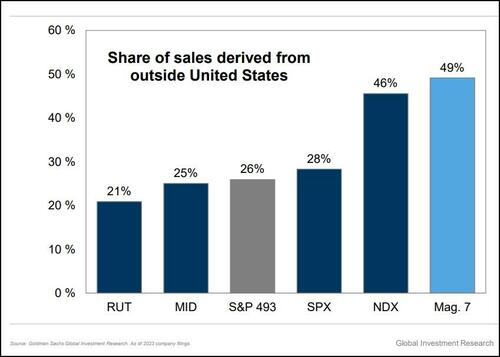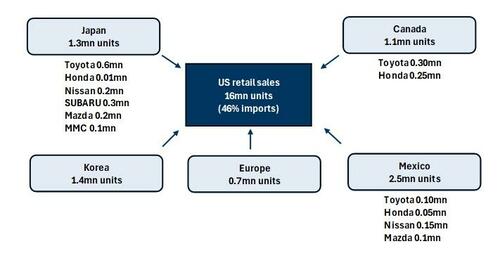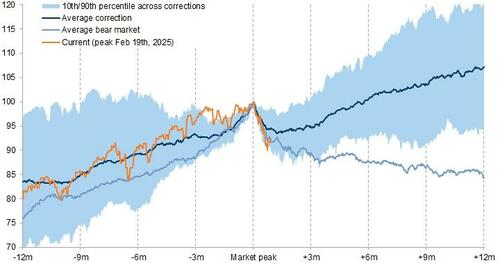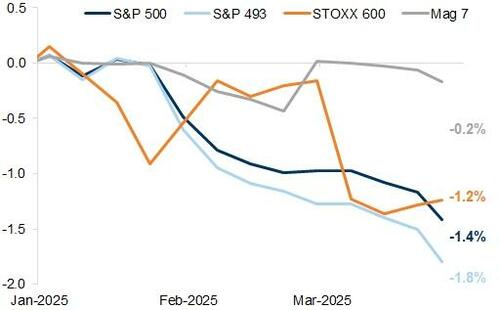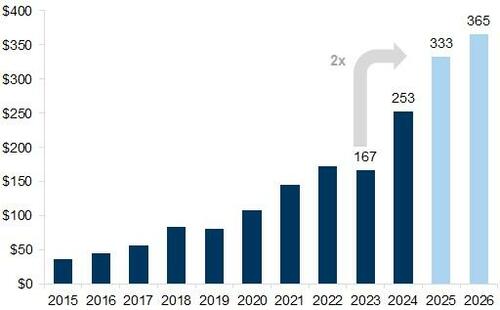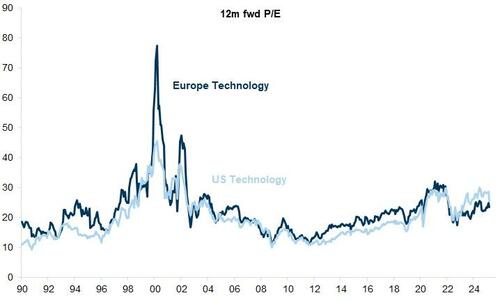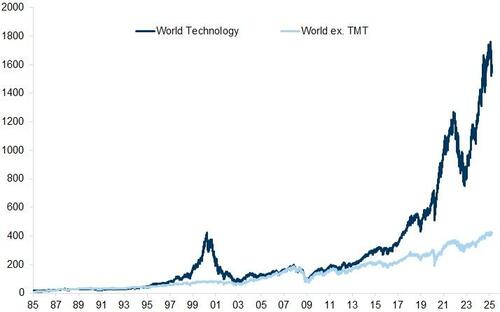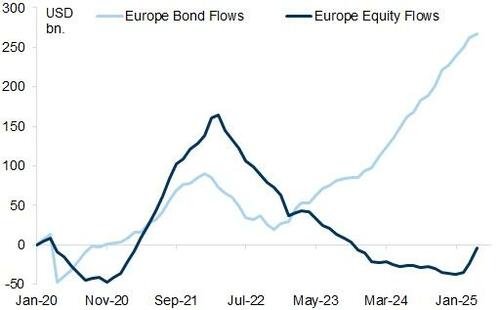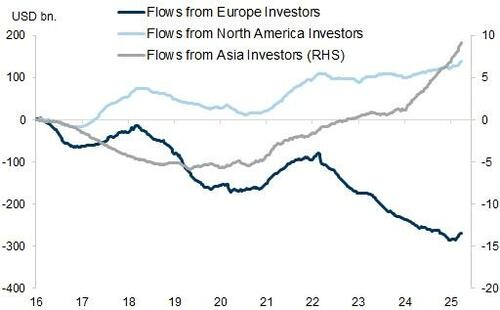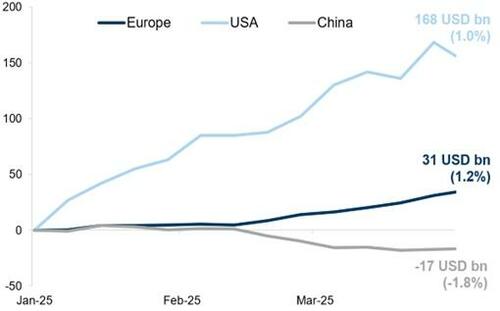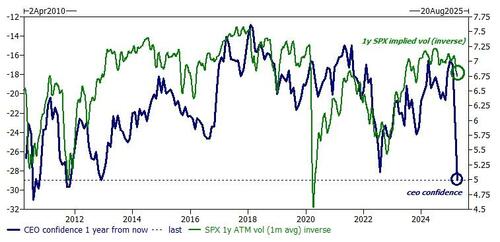Uddrag fra Goldman Sachs Macro Trader
How much things have changed….time will tell. But it feels like an ‘end of history’ and move to a new era of economic warfare, de-globalisation and verticalization around regions and protectionism. It may also start that journey with a repricing of growth and a potential recession or worse.
The S&P fell 4.8% yday…for the biggest one day move since 2020. It is down another ~3.5% so far today. SPX…going to open later and will be down ~11% on the year. The sentiment that was creeping towards cautious has tilted into fearful. If history is anything to go by…quite often thing become a bit self fulfilling from here.
That being said, that degree of pessimism is hard to reconcile with a growing (for now) world….and major economies at or near full employment.
A year that started with confidence, hope, belief and animal spirits. A January that yielded market performance and returns. An inauguration that may now, in hindsight, have been the beginning of the end. And then a series of blips…following by a few bumps…and the with liberation day….a big bang.
Today….there is more panic. There is more urgency. There is more action.
Post China I think that will accelerate…and people are going to look to degross…hedge….rotate to quality , defensive and safety.
A January that saw a near zero probability of recession….has turned into a April with a 50% probability of recession and rising. A January where the primary debate around Fed cuts revolved around inflation normalisation debates…..has turned into April with up to 100bps of Fed cuts being priced in to fend off the slow down. A January littered with all time highs across indices (including places like Germany and the UK)…has turned into an April with a sharp draw down and debates around where the S&P can/should settle from a multiple perspective (is it 22x is it 20x or do we go back to long term avg of 18x?!).
More importantly….it feels like we are moving into a world of de-globalisation, trade wars…
What went wrong?
It felt like US had all the cards in January.
A president with a mandate, an economy that was strong, a currency that was powerful, an inflation problem that was diminishing, growth and Ai…and the mercurial Musk setting his high powered brain towards driving efficiency and cost savings through the governmental administrative branch. There was a market view that Trump cared about the markets…and views that as a totemic reflection of his ‘performance’….and as such Equities were underpinned by a ‘Trump put’. He filled his cabinet with ‘followers and believers/ and then set about fixing the trade imbalances he perceived via the use of Tariffs. Then, in my personal view, they pushed to hard and broke things.
The Tariff theory may make sense for the US…a long overdue need to ‘balance the books’…the process, the uncertainty and the quantum I think (and the market agrees) have not been a success. The actions seem to have had a negative effect around confidence and sentiment domestically and triggered a material increase in recession risk. What started out as a cooling effect that impacted M&A and Capex has turned into a growth shock that will now have broader implications. It is very well fixing a problem….but you don’t solve broken arms by cutting off limbs. It does feel, now, that we are moving towards a period of uncertainty and Trade/Tariff tit for tat. A more verticalized operating model for trade…and with it a lot of grit and sand being thrown into the gears of growth. Colleagues in FICC reminded me that ‘stagflation increases prices at the expense of volumes, and so is bad for earnings, forces wider deficits and creates another thin landing strip
The focus on efficiency had a cooling effect on the work force. The Tariff narrative has had an impact on global and domestic growth. The treatment of allies has had a dual impact of galvanising a response. some of these things feeding through with voters. I thought it interesting to see the margin of victory for the 2 open congressional Florida seats tighten from ~37 points to ~12 points…..and the Wisconsin supreme court seat going to a democrat…and Cory Booker 25 hour ‘filibuster-esque speech’ around everything that is wrong in America. Midterms aren’t a million miles away….and the triple lock mandate that Trump had in Jan feels a bit weaker today.
Then….an hour ago…China responded.
Counter Tariffs on US goods….export controls on rare earth related good. With that news….basis risk and gross exposure now the focus. And stress levels rising at the point of trade….v quickly.
What am I watching from here…
Dominos/positioning/flows. So broad risk off yday…with a focus on Tariff and Recession exposure. Today we go a bit more Micro and we see European banks and SX7E trading down 5.7%..partly on recession…party on $ funding…partly on crowding and positioning. Cyclical vs defensives having a massive (and understandable) spread move. Yday was all about the faster moving segments of the market…..moving hard and fast to price in what they think is coming…and pre-empting the heavier pools of liquidity engaging in shifting course. Into the close yday we began to see that…and continued to see Long only selling through the US session and today in Europe more of the same with mutual fund and pension fund supply and net selling across high vol names, growth, momentum, liquid….pretty much everything frankly. The only demand we see have been interest rate sensitive (ex banks), quality, profitability.
Market structure. As mentioned above….the speed of markets are faster than ever before. Some of the factors discussed previously around market structure changes means that efficiency of markets ‘pivoting’ is faster and sharper than I’ve seen before. The nature of ‘volumes’ and ‘flows’ has gradually shifted to shorter durations, more systematic and shallower…and less fundamental in nature. In a trending market….that is low vol….that is fine…but if and when we start to see, need, trade matrial risk transfers…..then that operating model will be tested.
Volumes vs Liquidity. A few different points here. Huge volumes….up materially…and that was from an elevated number vs 2024 averages. Yday our volumes across EMEA on our platform we’re up 60% vs the 20 day average…and we saw one of our highest volume days in 5 years. As a geeky stat…. we processed 6.44bn market data ticks yday for a record number….more than Trump election victory, more than Nikkei flash crash day, more than Ukraine invasion day. The ticks are a proxy for volatility and the the re-engineering of a market from paper tickets and humans…..to market data and algorithms. platform we That being said….it did not come with market depth and liquidity. John Flood rightly points to US top of order book liquidity going from $13m down to $7m….to yday at one point hitting $4m. We are seeing the lack of depth in bid offers across Europe and the gappy nature of how things trading and the growing impact around flows. A recipe of high volume and low liquidity…is a dangerous one…watching this closely.
X-asset moves and correlations. The Equities move have been well documented…..I felt there wasn’t enough commentary on the Oil move yesterday…the quantum of the FX moves is so dramatic ($/CHF had a 5+ standard deviation move as one example) they have to have broader impacts in terms of asset managers, asset allocators and capital flows. I also am watching for X-asset contagion. It was interesting to me that during the Nikkei summer 24 flash crash….or the March 25 degross….HY and credit markets didn’t move. What happens if we have a deeper broader degross where equities, credit, commods, fx all move wrong way for investors…and netting risks and gross risk exposures result in more mechanical selling? Def something to keep an eye on….and credit is where I’m watching….which feels pretty tight to me relative to the risks and what I’m seeing elsewhere.
Trump’s base. The moves for Equities….the moves for Bitcoin….the potential moves for real estate. It does feel that the wealth effect halo that has shone brightly since covid is now diminishing. President Trump said yday he hadn’t checked his 401k….but if he had…he would have seen what most Americans have seen (or are about to see)…they are poorer than they were in January. Another interesting point made to me…Trumps base has shifted younger….and continues to poll well with that community….if you shift the debate from impacts today….to impacts in the future and legacy….then is this a proxy transfer of wealth and opportunity from the haves to te have nots….and from the old to the young? Does this creates an opportunity for the asset light to invest at a better entry prices in markets….to own houses at cheaper prices with lower cost of debt…and to create wage inflation in the segments where they live in the pay ‘waterfall’?
Payrolls and newsflow. Weekend with likely news and noise everywhere hard to envisage a re-gross with this degree of uncertainty. I imagine we will hear more from Europe…more from China…more from many around the response to the response in relation to Tariffs. There will likely be plenty of written words on precedents around slowdowns and recession risks. There will also be a lot of reminders globally around where we have come from in terms of mark to markets and valuations.
The $. The $ move interesting. Usually we’d see a flight to safety in time of uncertainty….but is the $ a proof point around credibility around US (spec around swap lines) diminishing…..and/or are we seeing debates around the $ as a reserve currency in the spot moves? Ultimately….owning US assets and being long $ has been a great tailwind over the last 10 years…that has reverted abruptly over the last few weeks. Then the 10 year trend of accruing $ length is resulting in a rush to ‘hedge’$ ….either by FX flattening or by selling exposure (mainly US tech so far). Will we start to see a buyers strike around $ denominated assets…eg Treasuries, Gold, Oil etc. (not likely). More possible is a potential change in China approach to CNH/$ which has been very stable of late…in spite of the growing tension. Here, could we see a change there an increase in volatility around reference rate like we saw in 2018…and what could that mean?
Ai. The forgotten story. How to price this ‘transformational’ technology in the midst of all this? I imagine as was the case with internet and the telcos and the infra plays….or internet and search….the short term focus will shirt to returns not stories in a market that is more fearful than hopefully.
Overnight Tariffs worse than market predicted and reaction to it has been swift and ugly.
End of day…hard to argue the Tariff ‘billboard’ can do anything but increase inflationary pressure, verticalize geographies and economies….and have a short term GDP negative impact. The probability of recession goes up….and the narrative of a Fed/Trump put is thrown away at current spot levels.
Less words….more charts
1, Tariffs.
2, The big 7 and impact of reciprocal Tariffs.
3, Deep dive on one sub sector and Tariffs
US-cars & tariffs: 46% of cars sold in the US are imported; 25% tariff on imported cars could raise the price by $5K to $15K; Moreover, assuming about 50% of parts content in US made cars is foreign (per the White House fact sheet), a 25% tariff could raise the cost of locally made vehicles by roughly $3K-$8K prior to any offsets. Link
4, Where are we in the sell off?
Historical sell-off: The S&P 500 sell-off has been sharper than the average correction in the last 100 years. Link
5, Sentiment catch down.
2025 EPS Revisions since the start of the year
Percentages
6, The forgotten story of Ai capex.
AI: The Magnificent 7 have roughly doubled their capex on AI in two years. Link
7, Tech now vs then.
The Tech Bubble: Especially Europe saw extravagant valuations in tech. Link
8, Tech as the driver of growth.
Market returns have been driven by a binary spread between technology and other sectors
Total return performance (USD). Indexed to 100 on Jan-2009
9, Mag 7 and regime change?
Mag 7: The dominance is a function of their vastly superior earnings power over the past decade. Link
10, China. Do they become a safer haven?
Chinese equities: The latest AI-powered rally is one of the most significant in history. Link
11, the flight to safety.
Europe bond and equity cumulative flows (USD bn)
12, Regional rotations.
US and Asia investors have long been the only buyers of European equities
Flows into developed Europe equity (weekly flows, USD bn)
13, European Flows
Recent European inflows are small compared to inflows into US equities over the same period
Cumulative global flows into regional equities; USD Billions (Indexed to Jan 2025) and as a % of AUM into each region at the start of the year
14, C suite sentiment
15, The $.
Unhedged returns….and foreign holdings.
good luck out there.
Intro-pris i 3 måneder
Få unik indsigt i de vigtigste erhvervsbegivenheder og dybdegående analyser, så du som investor, rådgiver og topleder kan handle proaktivt og kapitalisere på ændringer.
- Fuld adgang til ugebrev.dk
- Nyhedsmails med daglige opdateringer
- Ingen binding
199 kr./måned
Normalpris 349 kr./måned
199 kr./md. de første tre måneder,
herefter 349 kr./md.
Allerede abonnent? Log ind her



